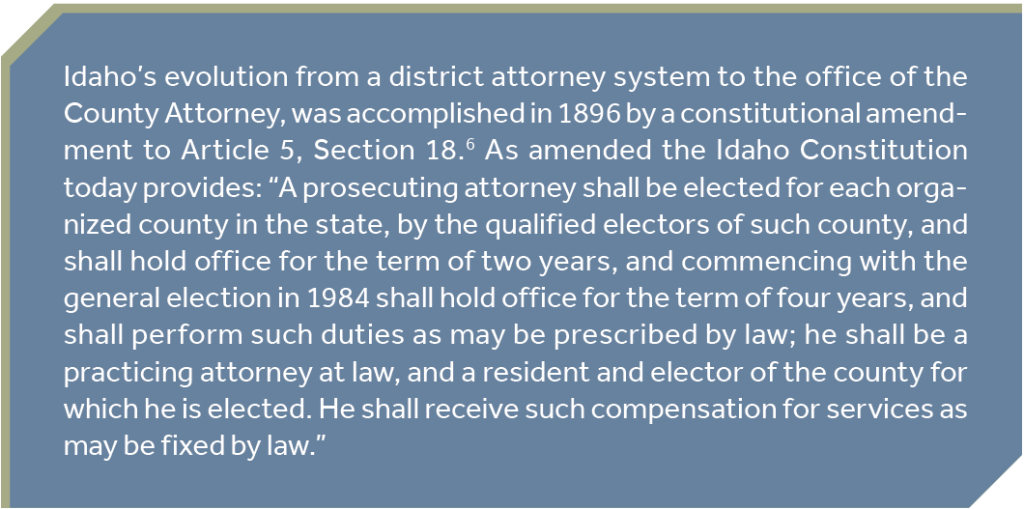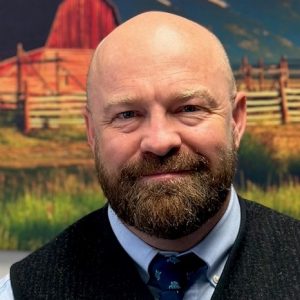The Dynamic Role of County Prosecutors: Nurturing Local Leadership and Community Engagement by Robert H. Wood
/*! elementor – v3.21.0 – 30-04-2024 */
.elementor-widget-image{text-align:center}.elementor-widget-image a{display:inline-block}.elementor-widget-image a img[src$=”.svg”]{width:48px}.elementor-widget-image img{vertical-align:middle;display:inline-block} 
by Robert H. Wood
The conventional image of a county prosecutor as a courtroom figure tasked solely with handling cases brought by local law enforcement is antiquated. To whatever extent this perception may have been accurate in the past, it no longer encapsulates the multifaceted role of county prosecutors in Idaho.
Today, county prosecutors fulfill a vital function that transcends the courtroom: serving as community leaders in the pursuit of justice, public safety, crime prevention, and legal counsel for their respective counties. Community engagement has emerged as a linchpin in the prosecutor’s mission, with outreach serving as a conduit for fostering partnerships and collaboration among stakeholders.
A Prosecutor’s Authority, Responsibilities, and Leadership Role
The legal authority of county prosecutors to prosecute cases is firmly rooted in the Idaho Constitution and statutes.[i] According to Idaho’s Constitution, a prosecuting attorney is elected for each organized county by its qualified electors.[ii] The Constitution further mandates that the prosecuting attorney must be a practicing attorney at law and a resident and elector of the county for which they are elected.[iii]
Additionally, Idaho Code Section 31-2604 delineates the duties of county prosecutors, including: (1) the prosecution of felonies and misdemeanors within their jurisdiction, (2) provision of legal counsel to county commissioners, and (3) handling of city/municipal misdemeanors through contractual agreements. They shall receive such compensation for services as may be fixed by law.[iv] County prosecutors are also responsible for holding local governments and officials legally accountable to the people. In the execution of these responsibilities, prosecutors spend extensive time in courtroom proceedings/litigation. Preparation for these proceedings requires reading police reports and witness statements, examining evidence, providing discovery, witness preparation and often requesting follow-up investigation from law-enforcement.
The time spent prosecuting crimes in court is increasingly just one facet of a county prosecutor’s duties. In today’s landscape, prosecutors find themselves engaged in both broad and niche areas such as child protection cases with the Department of Health and Welfare and collaboration with mental health services for individuals facing mental health crises. County Prosecutors share jurisdiction over child protection actions with the Idaho Attorney General.[v]
Idaho’s evolution from a district attorney system to the office of the County Attorney, was accomplished in 1896 by a constitutional amendment to Article 5, Section 18.
Since that time, the election of County Attorneys underscores the significance of local representation in selecting county prosecutors. Allowing the members of each county to choose their local prosecutor was wise in 1896, and it is still wise 128 years later. Local governments generally have more influence on our lives and livelihood than state and national government, making it even more important that individuals in each county have a voice in choosing who represents them.
Additionally, prosecutors serve at the center of the criminal justice ecosystem, providing important checks and balances that allow the system to work properly. By actively listening and communicating, prosecutors can foster transparency and understanding for anyone working in or affected by that ecosystem. Gallup polling reports that Americans tend to trust local government more than other forms of government.[vii] Local prosecutors should continue to build on that trust by being open in their outreach to community members.
Challenges of a Growing Idaho and Local Responsiveness
Government closest to the people is more likely to be responsible to the people it represents, more effective in that representation, and more responsive to the individuals and local needs of a community.
In 2022, Idaho was the second fastest growing state,[viii] and in 2023, Idaho was deemed the fourth nationally in percentage growth in the country.[ix] As Idaho experiences rapid growth, each county grapples with distinct challenges, demographic shifts, and evolving priorities. For instance, the transformation of Madison and Teton Counties – which border each other in the Southeastern corner of the state – from small agricultural communities to diverse economic landscapes illustrates the dynamic nature of Idaho’s counties.
When originally settled, these two counties were both primarily small agricultural communities that shared many of the same pioneering families. With the growth in Southeast Idaho in recent years[x], the two counties are now very different from one another. While both counties fortunately still maintain much of their agricultural heritage, Teton County has relied increasingly on tourism and the outdoor industry for growth.[xi] Meanwhile Madison County has rapidly grown and become more of a “college town” due to the growth of BYU-Idaho in Rexburg.[xii] This growth has created changes in demographics, local priorities, and political values.
County prosecutors elected by the local populations are best situated to effectively respond to these changes. The imperative for local responsiveness has never been more pronounced. With the current trend of low trust and confidence in government[xiii], the democratic process of electing local county prosecutors ensures accountability, effectiveness, and responsiveness to local needs and is more important than ever.
Embracing Community Outreach
In the context of Idaho’s growth and evolving communities, community outreach has never been more important and emerges as a pivotal tool for county prosecutors. Each county’s outreach strategy must reflect its unique characteristics to engage stakeholders effectively. As leadership author John Graham aptly notes: “It’s (leadership) not simply a set of rules to be followed, but an ability to build relationships . . .. Good leaders don’t depend on their position to give them authority; they depend on earning trust. They don’t mandate good performance from those they lead; they inspire it.”[xiv]
While the prosecutor’s traditional role as a courtroom litigator is still important, prosecutors increasingly need to involve their communities and stakeholders to fulfill their mission of pursuing justice, prosecuting crime, and providing for community safety. With the rapid change in Idaho counties, that outreach will look different in each county. What works in one community may not work in another community. Prosecutors can, and should, embrace a style of leadership that accounts for the local values and priorities, invites input from their community, and helps to empower the people who live there. One way to accomplish this is to look for ways to invite public input. This can be done easier than ever before with official social media or websites where the public can comment. Also, the value of meeting face-to-face in a townhall setting can never be overestimated.
Community outreach catalyzes trust-building, transparency, and collaboration. By actively engaging with constituents, prosecutors gain invaluable insights into community concerns, perceptions, and priorities, thereby fostering a stronger sense of accountability and legitimacy.

Preventing Crime Through Partnership
Partnerships with community stakeholders are indispensable for crime prevention initiatives. Collaboration with the people we represent aids in their understanding of the criminal justice system and their role in keeping their communities safe. Programs like Adolescents Making Progress (“AMP”) in Madison County exemplify these collaborative efforts and help communities shepherd youth away from criminal activity.
AMP consists of prosecutors, school resource police officers, education leaders (school principals, vice principals, teachers, etc.) and juvenile probation. AMP meets regularly to discuss at-risk youth and looks for solutions to help those youth before they become involved in the juvenile justice system. Alternatively, for those children who have been charged, AMP looks for ways to support them in their probation/diversion programs and to help re-engage them in their education.
Educational outreach initiatives aimed at children and young adults play a pivotal role in preventing criminal behavior and promoting legal literacy. Through school assemblies, community workshops, and public awareness campaigns, prosecutors can educate children and their parents about emerging threats such as internet crimes against children engage youth and empower individuals to make informed decisions and avoid victimization. Addressing elder fraud crimes has a similar approach, as prosecutors work with senior centers to help educate older adults and their adult children to protect their retirement accounts.
Collaborative Relationships
Effective collaboration with law enforcement agencies, victim services, advocacy centers, and social service agencies underscores the prosecutor’s commitment to holistic justice. Maintaining professional relationships with law enforcement ensures seamless information-sharing, adherence to due process, and enhanced public trust in the criminal justice system. While prosecutors must avoid being a rubber-stamp for police, the importance of maintaining appropriate and productive relationships with our law enforcement partners cannot be overstated.
Similarly, the relationship of the Prosecutor’s office with misdemeanor, juvenile, and felony probation is necessary to ensure that probationers follow through on their commitment to probation. In Madison County, a strong emphasis is placed on working with juvenile probation in multiple groups and programs such as the aforementioned AMP, our Multi-Disciplinary Teams, and our diversion program to help youth learn from their mistakes, focus on their education, and grow to become productive citizens.
Victim advocates play a crucial role in supporting and empowering victims throughout the legal process, safeguarding their constitutional rights, and facilitating access to essential social services. Too often, a victim may have apprehension about taking part in the legal process, even when they have been physically harmed.
Victim advocates aid prosecutors in communicating with victims and understanding each victim’s concerns, needs, and preferences. In cases where a victim may be in danger from a defendant, victim advocates can provide safe housing and help in obtaining civil protection orders. Without local relationships with service providers, our ability to assist in keeping victims safe would decrease dramatically.
/*! elementor-pro – v3.21.0 – 30-04-2024 */
@charset “UTF-8″;.entry-content blockquote.elementor-blockquote:not(.alignright):not(.alignleft),.entry-summary blockquote.elementor-blockquote{margin-right:0;margin-left:0}.elementor-widget-blockquote blockquote{margin:0;padding:0;outline:0;font-size:100%;vertical-align:baseline;background:transparent;quotes:none;border:0;font-style:normal;color:#3f444b}.elementor-widget-blockquote blockquote .e-q-footer:after,.elementor-widget-blockquote blockquote .e-q-footer:before,.elementor-widget-blockquote blockquote:after,.elementor-widget-blockquote blockquote:before,.elementor-widget-blockquote blockquote cite:after,.elementor-widget-blockquote blockquote cite:before{content:none}.elementor-blockquote{transition:.3s}.elementor-blockquote__author,.elementor-blockquote__content{margin-bottom:0;font-style:normal}.elementor-blockquote__author{font-weight:700}.elementor-blockquote .e-q-footer{margin-top:12px;display:flex;justify-content:space-between}.elementor-blockquote__tweet-button{display:flex;transition:.3s;color:#1da1f2;align-self:flex-end;line-height:1;position:relative;width:-moz-max-content;width:max-content}.elementor-blockquote__tweet-button:hover{color:#0967a0}.elementor-blockquote__tweet-button span{font-weight:600}.elementor-blockquote__tweet-button i,.elementor-blockquote__tweet-button span{vertical-align:middle}.elementor-blockquote__tweet-button i+span,.elementor-blockquote__tweet-button svg+span{margin-inline-start:.5em}.elementor-blockquote__tweet-button svg{fill:#1da1f2;height:1em;width:1em}.elementor-blockquote__tweet-label{white-space:pre-wrap}.elementor-blockquote–button-skin-bubble .elementor-blockquote__tweet-button,.elementor-blockquote–button-skin-classic .elementor-blockquote__tweet-button{padding:.7em 1.2em;border-radius:100em;background-color:#1da1f2;color:#fff;font-size:15px}.elementor-blockquote–button-skin-bubble .elementor-blockquote__tweet-button:hover,.elementor-blockquote–button-skin-classic .elementor-blockquote__tweet-button:hover{background-color:#0967a0;color:#fff}.elementor-blockquote–button-skin-bubble .elementor-blockquote__tweet-button:hover:before,.elementor-blockquote–button-skin-classic .elementor-blockquote__tweet-button:hover:before{border-inline-end-color:#0967a0}.elementor-blockquote–button-skin-bubble .elementor-blockquote__tweet-button svg,.elementor-blockquote–button-skin-classic .elementor-blockquote__tweet-button svg{fill:#fff;height:1em;width:1em}.elementor-blockquote–button-skin-bubble.elementor-blockquote–button-view-icon .elementor-blockquote__tweet-button,.elementor-blockquote–button-skin-classic.elementor-blockquote–button-view-icon .elementor-blockquote__tweet-button{padding:0;width:2em;height:2em}.elementor-blockquote–button-skin-bubble.elementor-blockquote–button-view-icon .elementor-blockquote__tweet-button i,.elementor-blockquote–button-skin-classic.elementor-blockquote–button-view-icon .elementor-blockquote__tweet-button i{position:absolute;left:50%;top:50%;transform:translate(-50%,-50%)}.elementor-blockquote–button-skin-bubble .elementor-blockquote__tweet-button:before{content:””;border:.5em solid transparent;border-inline-end-color:#1da1f2;position:absolute;left:-.8em;top:50%;transform:translateY(-50%) scaleY(.65);transition:.3s}.elementor-blockquote–button-skin-bubble.elementor-blockquote–align-left .elementor-blockquote__tweet-button:before{right:auto;left:-.8em;border-right-color:#1da1f2;border-left-color:transparent}.elementor-blockquote–button-skin-bubble.elementor-blockquote–align-left .elementor-blockquote__tweet-button:hover:before{border-right-color:#0967a0}.elementor-blockquote–button-skin-bubble.elementor-blockquote–align-right .elementor-blockquote__tweet-button:before{left:auto;right:-.8em;border-right-color:transparent;border-left-color:#1da1f2}.elementor-blockquote–button-skin-bubble.elementor-blockquote–align-right .elementor-blockquote__tweet-button:hover:before{border-left-color:#0967a0}.elementor-blockquote–skin-boxed .elementor-blockquote{background-color:#f9fafa;padding:30px}.elementor-blockquote–skin-border .elementor-blockquote{border-color:#f9fafa;border-style:solid;border-inline-start-width:7px;padding-inline-start:20px}.elementor-blockquote–skin-quotation .elementor-blockquote:before{content:”“”;font-size:100px;color:#f9fafa;font-family:Times New Roman,Times,serif;font-weight:900;line-height:1;display:block;height:.6em}.elementor-blockquote–skin-quotation .elementor-blockquote__content{margin-top:15px}.elementor-blockquote–align-left .elementor-blockquote__content{text-align:left}.elementor-blockquote–align-left .elementor-blockquote .e-q-footer{flex-direction:row}.elementor-blockquote–align-right .elementor-blockquote__content{text-align:right}.elementor-blockquote–align-right .elementor-blockquote .e-q-footer{flex-direction:row-reverse}.elementor-blockquote–align-center .elementor-blockquote{text-align:center}.elementor-blockquote–align-center .elementor-blockquote .e-q-footer,.elementor-blockquote–align-center .elementor-blockquote__author{display:block}.elementor-blockquote–align-center .elementor-blockquote__tweet-button{margin-right:auto;margin-left:auto}
“While the prosecutor’s traditional role as a
courtroom litigator is still important,
prosecutors increasingly need to involve
their communities and stakeholders to fulfill
their mission of pursuing justice, prosecuting
crime, and providing for community safety.”
Increasingly, advocacy and social service centers for both adults and children are providing resources that help prosecutors and law enforcement by providing rooms for forensic interviews of children and rooms for Sexual Assault Nurse Examinations. These services aid victims by limiting the number of offices, hospitals, and police departments they must visit to properly report abuse. Victim advocates are a voice for victims and help prosecutors ensure that victims’ rights are protected throughout the life of the criminal case.
When collaborating with victim’s services, it is necessary to remember that the victim advocate’s mission will sometimes lead to different goals for a case than the prosecutors. Open, honest, and frequent communication between prosecutors and victim advocates is crucial to maintaining a professional, working relationship.
Conclusion
As Idaho continues to experience population growth and the accompanying shifts, the role of county prosecutors in Idaho necessitates a proactive, customized, and multifaceted approach to leadership, community engagement, and crime prevention. As legal representatives of their communities, county prosecutors must always remain steadfast in their commitment to justice, accountability, and public safety. But by embracing community outreach, fostering collaborative partnerships, and prioritizing local responsiveness, prosecutors can effectively navigate the complexities of modern law enforcement and safeguard the unique interests of their constituents.
/*! elementor – v3.21.0 – 30-04-2024 */
.elementor-widget-image-box .elementor-image-box-content{width:100%}@media (min-width:768px){.elementor-widget-image-box.elementor-position-left .elementor-image-box-wrapper,.elementor-widget-image-box.elementor-position-right .elementor-image-box-wrapper{display:flex}.elementor-widget-image-box.elementor-position-right .elementor-image-box-wrapper{text-align:end;flex-direction:row-reverse}.elementor-widget-image-box.elementor-position-left .elementor-image-box-wrapper{text-align:start;flex-direction:row}.elementor-widget-image-box.elementor-position-top .elementor-image-box-img{margin:auto}.elementor-widget-image-box.elementor-vertical-align-top .elementor-image-box-wrapper{align-items:flex-start}.elementor-widget-image-box.elementor-vertical-align-middle .elementor-image-box-wrapper{align-items:center}.elementor-widget-image-box.elementor-vertical-align-bottom .elementor-image-box-wrapper{align-items:flex-end}}@media (max-width:767px){.elementor-widget-image-box .elementor-image-box-img{margin-left:auto!important;margin-right:auto!important;margin-bottom:15px}}.elementor-widget-image-box .elementor-image-box-img{display:inline-block}.elementor-widget-image-box .elementor-image-box-title a{color:inherit}.elementor-widget-image-box .elementor-image-box-wrapper{text-align:center}.elementor-widget-image-box .elementor-image-box-description{margin:0}

Robert H. Wood
Robert H. Wood has been the Madison County Prosecutor since January 2020. He started working in that office in 2014. Prior to that he practiced water law and criminal defense for five years at Rigby, Andrus & Rigby in Rexburg. He enjoys hiking and skiing/snowboarding with his wife and three kids.
[i] Idaho Const. art. V, § 18; Idaho Code § 31-2604.
[ii] Idaho Const. art. V, § 18.
[iii] Id.
[iv] Id.
[v] Idaho Code § 16-1610.
[vi] Idaho Constitutional Amendment History, Idaho Secretary of State. https://sos.idaho.gov/elect/inits/hst92_18.htm.
[vii] Jeffrey Jones, Americans Trust Local Government Most, Congress Least, GALLUP, October 13, 2023. https://news.gallup.com/poll/512651/americans-trust-local-government-congress-least.aspx.
[viii] Clark Corbin, Idaho was second-fastest growing state in the U.S. in 2022, IDAHO CAPITAL SUN, January 4, 2023. https://idahocapitalsun.com/2023/01/04/idaho-was-second-fastest-growing-state-in-the-u-s-in-2022/.
[ix] Nick Rosenberger, Idaho Population Could Hit 2 Million Any Day Now, Passing Nebraska, Thanks California!, IDAHO STATESMAN, January 15, 2024. https://www.idahostatesman.com/news/business/article283986238.html.
[x] Eastern Idaho – Power of Place!, Rediconnects.Org. https://www.rediconnects.org/media/2tpha5dy/eastern-idaho-profile-5-26-22.pdf.
[xi] Brittany Skelton, Recreation Planning & Implementation in Southern Teton Valley, Idaho, The Western Planner. https://www.westernplanner.org/2020articles/2020/7/15/recreation-planning-amp-implementation-in-southern-teton-valley-idaho.
[xii] Jakob Thorington, Census Projects More Accurate Rexburg Population Than 2010 Census, REXBURG STANDARD JOURNAL, August 30, 2021. https://www.rexburgstandardjournal.com/news/local/census-projects-more-accurate-rexburg-population-than-2010-census/article_d903e102-091d-52d6-ba13-c44dd079d179.html.
[xiii] Trust in Government, GALLUP. https://news.gallup.com/poll/5392/trust-government.aspx.
[xiv] John Graham, Outdoor Leadership: Technique Common Sense & Self-Confidence 11–12 (1997).

